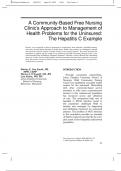FCH/Aspen Publisher, Inc. AS129-07 August 13, 2002 10:26 Char Count= 0
A Community-Based Free Nursing
Clinic’s Approach to Management of
Health Problems for the Uninsured:
The Hepatitis C Example
Poverty, as an outgrowth of lack of opportunity in employment, basic education, affordable housing,
and racism, directly affects disparities in health status. Health care providers are challenged to identify
and overcome systemic barriers to health services for the poorest patients. This article describes the
population of patients and the model of care offered by the Wald Community Nursing Center, a free
nurse-managed clinic in Baltimore, Maryland. Hepatitis C infection is used to illustrate the confounding
factors of a costly, chronic health problem and the interventions that have been instituted to overcome
them. Key words: community health nursing, community partnerships, hepatitis C, nursing center,
underserved, uninsured
Shirley E. Van Zandt, MS, INTRODUCTION
MPH, CRNP
Marion I. D’Lugoff, MA, RN Through community partnerships,
Lisa Kelley, MS, RN Johns Hopkins University School of
Johns Hopkins University Nursing’s Wald Community Nursing
School of Nursing
Center has established accessible health
Baltimore, Maryland
centers for the uninsured. Networking
with other community-based service
providers to offer more comprehensive
services to this underserved population
has increased access and utilization
of care. The unexpected high rate of
hepatitis C (HCV) infection found in
this population challenged Wald to
develop new strategies for diagnosing
and facilitating treatment for uninsured
patients. The problem of HCV infection
in this population provides an example
of Wald’s model of care that fits the com-
plex needs of this frequently underserved
population.
Fam Community Health 2002;25(3):61–70
c
° 2002 Lippincott Williams & Wilkins, Inc.
61
, FCH/Aspen Publisher, Inc. AS129-07 August 13, 2002 10:26 Char Count= 0
62 FAMILY & COMMUNITY HEALTH/OCTOBER 2002
BACKGROUND G.A.T.E. (Gaining Access to Training
and Employment), a program agency of
The Wald Community Nursing Center, HEBCAC, works to improve employa-
named after Lillian D. Wald, pioneer pub- bility through GED classes, job retrain-
lic health nurse and activist, is the first ing programs, employment counseling,
nurse-managed, free clinic at Johns Hop- and connections with employers. The
kins University, established by the School G.A.T.E. serves adults who are in need of
of Nursing in 1994. The mission of Wald jobs. Many of their clients have dropped
is to improve the vitality, quality of life, out of high school, have had unsuccess-
and health of the residents of Baltimore ful work experiences, and are trying to
by closing the gap to accessible, accept- disengage from welfare assistance.
able, and available health care for poor
uninsured and underinsured families. The THE POPULATION:
clinical expertise of the faculty, student UNEMPLOYMENT
nurses, and staff are matched with com- AND ITS LEGACY
munity partner agencies that can bene-
fit from community health and/or nurse The association between low socioe-
practitioner services. conomic status, poor health status, and
Wald has five clinical sites, each pro- limited access to health promotion and
viding service to a specific subgroup of basic health care services has long been
the population based on the partner- understood. Baltimore’s 64% African-
ships with a community agency: one lo- American population1 faces a 50% adult
cated in a refurbished housing develop- uninsured rate.2 The 1990 U.S. Census
ment whose interventions are focused on estimated that 22% of the city’s residents
community stabilization, a second in a lived at or below the Federal poverty
new Catholic elementary school, and two level.3 The average annual unemploy-
more offering community health nursing ment rate for 2000 for Baltimore city was
and nurse practitioner services to popu- 8.1%, compared with the Maryland state
lations of women and children in a com- average of 3.9% for the same period.4
munity center and a shelter for battered Nearly half of Baltimore’s adult uninsured
women. population works at jobs where health
The fifth and newest Wald site is in coverage is either unavailable or unafford-
partnership with a community agency able to the employee.2
that provides training and employment As many middle-class people have left
support to people living in a federally the city, so have thousands of jobs in
designated Empowerment Zone. Wald industries that paid a living wage and
has developed a collaborative partnership provided subsidized health insurance
with the Historic East Baltimore Com- coverage. As an example, the loss
munity Action Coalition (HEBCAC), a of 60,000 solid, blue-collar jobs over
local community agency of the feder- the past 10–20 years at a Bethlehem
ally designated Empowerment Zone ad- Steel plant and its associated Baltimore
ministered by Empower Baltimore. The port have left many men and women




